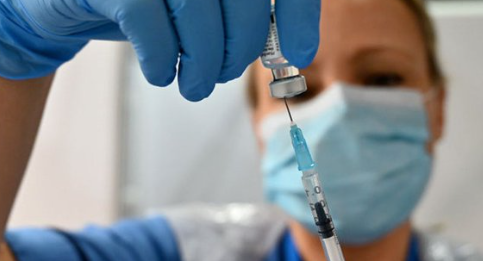- According to the Centers for Disease Control and Prevention (CDC), approximately 81% of the U.S. population has received at least one dose of a COVID-19 vaccine.
- Around 70% of the population is fully vaccinated, meaning they have received all the recommended doses of the vaccine, which includes the initial series and, for some, booster doses.
The U.S. Food and Drug Administration (FDA) approved updated COVID-19 vaccines from Pfizer and Moderna on Thursday, positioning the new shots to be available to the public in the coming days. This approval comes at a critical time, as the U.S. is experiencing a summer surge in COVID-19 cases.
The new vaccines target a specific strain known as KP.2, a descendant of the highly contagious omicron subvariant JN.1, which was the dominant strain in the U.S. earlier this year. Although KP.2 now accounts for just 3% of cases, Pfizer and Moderna have stated that their updated vaccines can generate a stronger immune response against other circulating subvariants of JN.1, such as KP.3 and LB.1, compared to the previous shots that targeted the omicron strain XBB.1.5.
US health authorities have approved the new updated Covid-19 vaccines from Pfizer and Moderna.
The FDA says the vaccines, developed using the KP.2 variant, target current Covid-19 variants and help reduce the risk of hospitalization or death.
— BFM News (@NewsBFM) August 23, 2024
Dr. Peter Marks, director of the FDA’s Center for Biologics Evaluation and Research, emphasized the importance of the updated vaccines in maintaining public health, particularly given the waning immunity from previous vaccinations and infections. He strongly encouraged eligible individuals to consider receiving the updated vaccine to better protect against currently circulating variants.
The Centers for Disease Control and Prevention (CDC) had already recommended in June that everyone over the age of six months receive an updated COVID-19 vaccine, alongside a flu shot this year. The newly approved vaccines from Pfizer and Moderna are specifically for individuals aged 12 and older, with emergency use authorization granted for children aged 6 months through 11 years.
Both Pfizer and Moderna are set to begin distributing their vaccines immediately, with availability expected in pharmacies, hospitals, and clinics across the U.S. within days. Moderna’s CEO, Stephane Bancel, stressed the importance of staying up to date with COVID-19 vaccinations to prevent severe illness and acknowledged the FDA’s timely review of the new vaccines.
The approval of these updated vaccines comes slightly earlier than last year’s batch, which was cleared on September 11. This earlier release is particularly timely as the nation grapples with a notable increase in COVID-19 cases. Wastewater monitoring data shows a “high” or “very high” level of COVID-19 presence in nearly every state, offering a snapshot of the virus’s spread amid declining traditional testing.
Other indicators, like test positivity rates and hospitalizations, are also rising, though they remain below pandemic peak levels. The recent COVID-19 wave might subside by the time the vaccines take full effect, which typically occurs two weeks post-vaccination. However, health officials have been preparing the public to expect annual updates to COVID-19 vaccines as the virus continues to evolve, similar to the flu vaccine rollout each year.
FDA approves updated Pfizer, Moderna Covid vaccines as virus surges; shots to be available within days
The Food and Drug Administration approved updated Covid vaccines from Pfizer and Moderna, putting the shots on track to reach most Americans in …https://t.co/jLv5Jb0giQ pic.twitter.com/wUzjazvQ7t
— JobRx.com (@jobrx) August 23, 2024
Despite the availability of these updated vaccines, it remains uncertain how many Americans will opt to receive another shot. Last fall, only about 22.5% of U.S. adults received the updated booster. Many cited a lack of concern about the virus or being too busy as reasons for skipping the booster.
In contrast to Pfizer and Moderna, Novavax, which filed for authorization of a new JN.1 shot in June, has not yet received FDA clearance. The company is working with the FDA to finalize the review process and expects its shot to be authorized in time for the peak vaccination season.
Information
- Booster Doses:
- About 40% of fully vaccinated Americans have received at least one booster dose. Booster uptake has been slower, with varying levels of participation depending on age groups and health status.
- Demographic Differences:
- Older adults (65+) have the highest vaccination rates, with over 90% fully vaccinated and a significant portion also receiving boosters.
- Among younger age groups, particularly those under 30, vaccination rates are lower, with around 60-70% fully vaccinated.
- There are also disparities based on geography, with higher vaccination rates in urban areas and lower rates in some rural regions.
- Vaccine Hesitancy:
- Vaccine hesitancy remains a challenge, with certain communities, particularly in the southern and midwestern states, showing lower vaccination rates due to mistrust or misinformation.
Key Points:
i. FDA approves updated COVID-19 vaccines from Pfizer and Moderna, targeting the KP.2 strain.
ii. The new vaccines are expected to be available across the U.S. in the coming days.
iii. The CDC recommends the updated vaccine for everyone over six months old, alongside a flu shot.
iv. Rising COVID-19 cases during the summer surge highlight the importance of the new vaccines.
v. Novavax is still awaiting FDA clearance for its vaccine, which targets a different strain.
Charles William III – Reprinted with permission of Whatfinger News

